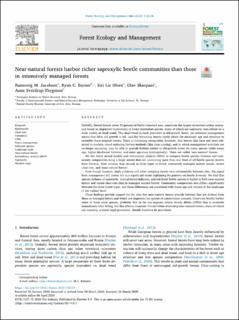Near-natural forests harbor richer saproxylic beetle communities than those in intensively managed forests
Jacobsen, Rannveig Margrete; Burner, Ryan C.; Olsen, Siri Lie; Skarpaas, Olav; Sverdrup-Thygeson, Anne
Journal article
Published version

Åpne
Permanent lenke
https://hdl.handle.net/11250/2651090Utgivelsesdato
2020Metadata
Vis full innførselSamlinger
- Scientific publications [1392]
Originalversjon
10.1016/j.foreco.2020.118124Sammendrag
Globally, boreal forests cover 33 percent of Earth's forested area, constitute the largest terrestrial carbon source, and house an important biodiversity of forest-dependent species, many of which are saproxylic taxa reliant on a wide variety of dead wood. This dead wood is most prevalent in old-growth forest, yet intensive management means that little oldgrowth is left, and there maining forests rarely attain the necessary age and structure to resemble these original forests. There is increasing recognition, however, that forests that have not been subjected to modern, stand-replacing harvest methods (like clear-cutting), and in which management activities are nolonger occurring, may be able to provide habitat similar to old-growth forest for many species (oldermean age, higher dead wood volumes, and more age-class heterogeneity). These are called ‘near-natural’ forests. We use linear mixed models and redundancy analysis (RDA) to compare beetle species richness and community composition using a large, mixed dataset, containing more than one third of all beetle species known from Norway, from window trap records in three types of forest: intensively managed mature stands, recent clear-cuts,and‘near-naturalforests’. Even though location, study substrate and other sampling details vary substantially between sites, the signal from management still comes out as a significant factor explaining the patterns on beetle diversity. We find that species richness of saproxylic, natural-forest indicator, and red-listed beetle species is higher in both near-natural forests and recent clear-cuts than in managed mature forests. Community compositional so differs significantly between the three forest types,and these differences are correlated with forest age and volume at the landscape (1km radius) level. These findings provide support for the idea that near-natural forests provide habitats that are distinct from those in managed forests and which are important for species of conservation concern. Clear-cuts briefly harbor some of these same species, probably due to the sun-exposed coarse woody debris (CWD) that is available immediately after felling, but this effect is transient. Conservation of existing near-natural forests, many of which are currently without legal protection, should therefore be prioritized.
